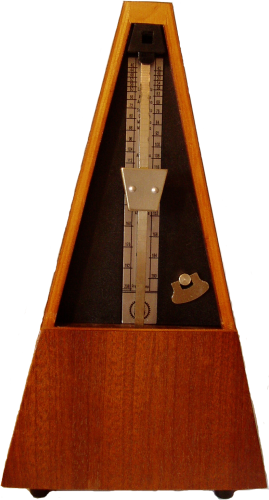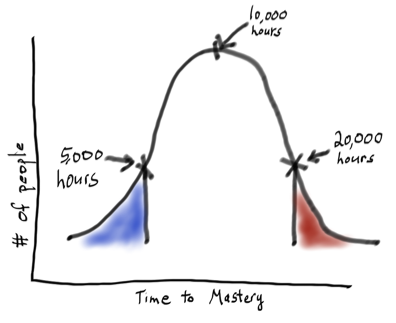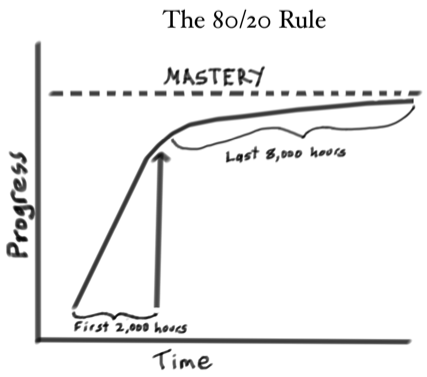Episode Two: How to Play “in the Zone”, and Why You Want to be There (Part Two)
First, let’s recap.
In part one, we said that:
- In order to learn how to play the banjo, we must create a dedicated neural network for each of the technical components of banjo playing. This is the purpose of practice.
- These neural networks take time for our brain to create, and the goal of our individual practice sessions is not to get better right then, but rather to provide our brain the inputs it needs to make those networks.
- Mistakes happen when we rush this process, when we proceed to learning new skills before the more basic ones they’re rooted in have been solidified – before the foundational neural network has been properly established.
- We can test whether a network has been properly established by testing for “automaticity”. A learned skill is defined as “automatic” when it can be performed while our conscious attention is directed elsewhere.
Experimentally, in snazzy neuroscience studies, “automaticity” is usually tested for by having a subject perform the learned skill while engaging in some arbitrary task on a computer – counting the number of blue squares that flash by, for example.
But is there a way for us to test automaticity for ourselves without any kind of specially designed digital equipment? Might there be some kind of device that’s tailor-made for the business of banjo learning, inexpensive, and delightfully analog?
Why of course. Here it is:

Now, before you run away screaming, let me explain.
I know the metronome has a dicey reputation. Like eating liver, flossing nightly, or routine colonoscopies, it’s one of those thing you know is probably good for you but you don’t exactly enjoy doing. So you put it off, or avoid it altogether.
But it’s time we changed your relationship to the metronome, because as you’ll soon discover it’s an indispensable tool in your learning arsenal, and using it can actually be great fun.
In my view, the metronome’s largely undeserved reputation is mainly based on two things.
First, playing along with the metronome isn’t something that comes naturally. For most folks, it’s not entirely clear what you’re supposed to be doing amidst all the incessant clicking. Do you only play with the clicks? In between the clicks? And what the heck is “largo” and “allegro”, anyhow?
So, just like you must know how a melody goes before you set about to play it, you must know how whatever you’re playing is supposed to sound along with the metronome before you get started. Otherwise you’ve sabotaged yourself from the start.
This is one reason I bring out the metronome very early in the 8 steps to clawhammer course, and demonstrate exactly where you’re to play in relation to the clicks (click here for an example).
Second, and most relevant to this discussion, is that folks tend to misinterpret the feedback they get from the metronome. Especially if it isn’t positive.
You see, most people think of the metronome as a tool for practicing their timing. And yes, it’s useful for this. But a greater – and often neglected – purpose of the metronome is as a test for automaticity.
Consider this: in order for you to successfully play along and in sync with the metronome, you must listen closely to its clicking while simultaneously making the proper movements of your picking and fretting hand to produce the desired sounds from your banjo.
In other words, when playing with the metronome, you’re performing a learned skill (whatever it is you’re practicing on the banjo that day) while your conscious mind is focused on something else (the metronome). And, to do this successfully, you must perform the learned skill just as well as you would without the metronome clicking away. In other words, the learned skill (your playing) mustn’t degrade even when your attention is directed elsewhere.
This, fellow fans of the five, is priceless feedback. Here we have a simple, inexpensive tool capable of peering into the brain and analyzing the state of our neural networks. We have the perfect litmus test for automaticity.
Unfortunately, this is not how most folks seem to interpret metronome feedback. The most common conclusion when things don’t go so well is “I guess I’m just no good with playing with the metronome” or, worse yet, “I’m a lousy player.”
But both of those conclusions are unjustified. And they stem from a basic misconception of what the metronome is all about, and why it’s useful.
So here’s a better, more productive, way to think about it. If you try playing along with the metronome and it doesn’t go so well, all it means is that the skill has yet to become automatic. If you have to devote your attention to the movement of your hands when the metronome is clicking, then it is biologically impossible to play in sync with it. The path just isn’t fully formed, and so a little more time is needed in the woodshed.
I should point out here, though it may be obvious to you, that you can use things besides a metronome for this purpose. All you need is some sort of external timekeeping device; something you have to focus your attention on whilst your hands are otherwise engaged in the business of picking.
One option could be another human being tapping their feet, clapping their hands, or banging a drum at a steady beat (provided they’re capable of such things), or, even better, a guitarist with solid rhythm strumming along.
I’m also a big fan of backing tracks (in fact, I’ve found them so helpful I’ve got a whole website full of hundreds of them!), which provide the added advantage of simulating a musical experience. So they’re a wonderful tool if you have access to them (or you can create your own). And, these days there are all sorts of free metronomic devices online, including this metronome playlist I compiled on youtube.
Suffice to say, you don’t have any excuses for not using one!
So this brings us to the 4th law of Brainjo, which is:
Brainjo Law #4: Test for automaticity by playing alongside an external timekeeping device
You can apply to this law to virtually anything new that you’re learning, whether it’s early techniques like hammer ons, pull offs, and basic chord shapes, a difficult bit of fingering in a particular tune, or an entire song.
With this fourth law established, we can create a foolproof and basic template/procedure to guide the pace of our learning anything new on the banjo, which is this:
- Practice the new thing until it gets easier, then
- Test for automaticity by playing along with an external timekeeping device
If you fail step 2, you just go back to step 1 and repeat the process. If you pass step 2, then you can move to the next item in your learning agenda, with the confidence that you’ve effectively carved out yet another pathway.
You’re now one step further to building your banjo playing brain.
Go to Episode 3: The Easiest Way to Get Better at Banjo



